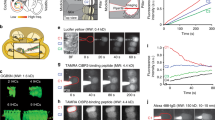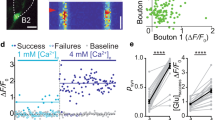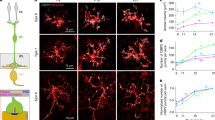Abstract
Neurotransmitters are released continuously at ribbon synapses in the retina and cochlea. Notably, a single ribbon synapse of inner hair cells provides the entire input to each cochlear afferent fiber. We investigated hair cell transmitter release in the postnatal rat cochlea by recording excitatory postsynaptic currents (EPSCs) from afferent boutons directly abutting the ribbon synapse. EPSCs were carried by rapidly gating AMPA receptors. EPSCs were clustered in time, indicating the possibility of coordinate release. Amplitude distributions of spontaneous EPSCs were highly skewed, peaking at 0.4 nS and ranging up to 20 times larger. Hair cell depolarization increased EPSC frequency up to 150 Hz without altering the amplitude distribution. We propose that the ribbon synapse operates by multivesicular release, possibly to achieve high-frequency transmission.
This is a preview of subscription content, access via your institution
Access options
Subscribe to this journal
Receive 12 print issues and online access
$209.00 per year
only $17.42 per issue
Buy this article
- Purchase on Springer Link
- Instant access to full article PDF
Prices may be subject to local taxes which are calculated during checkout








Similar content being viewed by others
References
von Gersdorff, H. Synaptic ribbons: versatile signal transducers. Neuron 29, 7–10 (2001).
Liberman, M. C. Morphological differences among radial afferent fibers in the cat cochlea: an electron-microscopic study of serial sections. Hear. Res. 3, 45–63 (1980).
Liberman, M. C. Single-neuron labeling in the cat auditory nerve. Science 216, 1239–1241 (1982).
Johnson, D. H. The relationship between spike rate and synchrony in responses of auditory nerve-fibers to single tones. J. Am. Stat. Assoc. 68, 1115–1122 (1980).
Beutner, D. & Moser, T. The presynaptic function of mouse cochlear inner hair cells during development of hearing. J. Neurosci. 21, 4593–4599 (2001).
Beutner, D., Voets, T., Neher, E. & Moser, T. Calcium dependence of exocytosis and endocytosis at the cochlear inner hair cell afferent synapse. Neuron 29, 681–690 (2001).
Moser, T. & Beutner, D. Kinetics of exocytosis and endocytosis at the cochlear inner hair cell afferent synapse of the mouse. Proc. Natl. Acad. Sci. USA 97, 883–888 (2000).
Parsons, T. D., Lenzi, D., Almers, W. & Roberts, W. M. Calcium-triggered exocytosis and endocytosis in an isolated presynaptic cell: capacitance measurements in saccular hair cells. Neuron 13, 875–883 (1994).
Spassova, M., Eisen, M. D., Saunders, J. C. & Parsons, T. D. Chick cochlear hair cell exocytosis mediated by dihydropyridine-sensitive calcium channels. J. Physiol. 535, 689–696 (2001).
von Gersdorff, H. & Matthews, G. Electrophysiology of synaptic vesicle cycling. Ann. Rev. Physiol. 61, 725–752 (1999).
Geisler, C. D. From Sound to Synapse Ch. 11, 177–179 (Oxford University Press, New York, 1998).
Siegel, J. H. Spontaneous synaptic potentials from afferent terminals in the guinea pig cochlea. Hear. Res. 59, 85–92 (1992).
Auger, C. & Marty, A. Quantal currents at single-site central synapses. J. Physiol. 526, 3–11 (2000).
Uziel, A., Romand, R. & Marot, M. Development of cochlear potentials in rats. Audiology 20, 89–100 (1981).
Glowatzki, E. & Fuchs, P. A. Cholinergic synaptic inhibition of inner hair cells in the neonatal mammalian cochlea. Science 288, 2366–2368 (2000).
Kros, C. J., Ruppersberg, J. P. & Rüsch, A. Expression of a potassium conductance in inner hair cells at the onset of hearing in mice. Nature 394, 281–284 (1998).
Otis, T. S., Wu, Y.-C. & Trussell, L. O. Delayed clearance of transmitter and the role of glutamate transporters at synapses with multiple release sites. J. Neurosci. 16, 1634–1644 (1996).
Partin, K. M., Patneau, D. K., Winters, C. A., Mayer, M. L. & Buonanno, A. Selective modulation of desensitisation at AMPA versus kainate receptors by cyclothiazide and concanavalin A. Neuron 11, 1069–1082 (1993).
Nakagawa, T., Komune, S., Uemura, T. & Akaike, N. Excitatory amino acid response in isolated spiral ganglion cells of guinea pig cochlea. J. Neurophysiol. 65, 715–723 (1991).
Ruel, J., Chen, C., Pujol, R., Bobbin, R. P. & Puel, J. L. AMPA-preferring glutamate receptors in cochlear physiology of adult guinea-pig. J. Physiol. 518, 667–680 (1999).
Ottersen, O. P. et al. Molecular organisation of a type of peripheral glutamate synapse: the afferent synapses of hair cells in the inner ear. Prog. Neurobiol. 54, 127–148 (1998).
Puel, J. L. Chemical synaptic transmission in the cochlea. Prog. Neurobiol. 47, 449–476 (1995).
Trussell, L. O. Synaptic mechanism for coding timing in auditory neurons. Ann. Rev. Physiol. 61, 477–496 (1999).
Isaacson, J. S. & Walmsley, B. Amplitude and time course of spontaneous and evoked excitatory postsynaptic currents in bushy cells of the anteroventral cochlear nucleus. J. Neurophysiol. 76, 1566–1571 (1996).
Zhang, S. & Trussell, L. O. Voltage clamp analysis of excitatory synaptic transmission in the avian nucleus magnocellularis. J. Physiol. 480, 123–136 (1994).
Rossi, M. L., Martini, M., Pelucchi, B. & Fesce, R. Quantal nature of synaptic transmission at the cytoneuronal junction in the frog labyrinth. J. Physiol. 478, 17–35 (1994).
Furukawa, T., Hayashida, Y. & Matsuura, S. Quantal analysis of the size of excitatory post-synaptic potentials at synapses between hair cells and afferent nerve fibres in goldfish. J. Physiol. 276, 211–226 (1978).
Locke, R., Vautrin, J. & Highstein, S. Miniature EPSPs and sensory encoding in the primary afferents of the vestibular lagena of the toadfish, Opsanus tau. Ann. NY Acad. Sci. 871, 35–50 (1999).
Llano, I. et al. Presynaptic calcium stores underlie large-amplitude miniature IPSCs and spontaneous calcium transients. Nat. Neurosci. 3, 1256–1265 (2000).
Auger, C., Kondo, S. & Marty, A. Multivesicular release at single functional synaptic sites in cerebellar stellate and basket cells. J. Neurosci. 18, 4532–4547 (1998).
Sahara, Y. & Takahashi, T. Quantal components of the excitatory postsynaptic currents at a rat central auditory synapse. J. Physiol. 536, 189–197 (2001).
Forti, L., Bossi, M., Bergamaschi, A., Villa, A. & Malgaroli, A. Loose-patch recordings of single quanta at individual hippocampal synapses. Nature 388, 874–878 (1997).
Liu, G. & Tsien, R. W. Properties of synaptic transmission at single hippocampal synaptic boutons. Nature 375, 404–408 (1995).
Bekkers, J. M., Richerson, G. B. & Stevens, C. F. Origin of variability in quantal size in cultured hippocampal neurons and hippocampal slices. Proc. Natl. Acad. Sci. USA 87, 5359–5362 (1990).
Lenzi, D., Runyeon, J. W., Crum, J., Ellisman, M. H. & Roberts, W. M. Synaptic vesicle populations in saccular hair cells reconstructed by electron tomography. J. Neurosci. 19, 119–132 (1999).
Echteler, S. M. Developmental segregation in the afferent projections to mammalian auditory hair cells. Proc. Natl. Acad. Sci. USA 89, 6324–6327 (1992).
Sobkowicz, H. M., Rose, J. E., Scott, G. L. & Slapnick, S. M. Ribbon synapses in the developing intact and cultured organ of Corti in the mouse. J. Neurosci. 2, 942–957 (1982).
Emmerling, M. R. et al. Biochemical and morphological differentiation of acetylcholinesterase-positive efferent fibers in the mouse cochlea. J. Elect. Micros. Tech. 15, 123–143 (1990).
Müller, M. The cochlear place–frequency map of the adult and developing mongolian gerbil. Hear. Res. 94, 148–156 (1996).
Maple, B. R., Werblin, F. S. & Wu, S. M. Miniature excitatory postsynaptic currents in bipolar cells of the tiger salamander retina. Vision Res. 34, 2357–2362 (1994).
Kros, C. J., Rüsch, A. & Richardson, G. P. Mechano-electrical transducer currents in hair cells of the cultured neonatal mouse cochlea. Proc. R. Soc. Lond. B 249, 185–193 (1992).
Acknowledgements
This work was supported by the US National Institute on Deafness and Other Communication Disorders (grant 00276) to P.A.F. We thank A.R. Martin for discussion and data analysis, T.D. Parsons for comments on the manuscript and H. Blum for the design of Figure 1.
Author information
Authors and Affiliations
Corresponding author
Rights and permissions
About this article
Cite this article
Glowatzki, E., Fuchs, P. Transmitter release at the hair cell ribbon synapse. Nat Neurosci 5, 147–154 (2002). https://doi.org/10.1038/nn796
Received:
Accepted:
Published:
Issue Date:
DOI: https://doi.org/10.1038/nn796
This article is cited by
-
Spontaneous activity in whisker-innervating region of neonatal mouse trigeminal ganglion
Scientific Reports (2022)
-
Diurnal changes in the efficiency of information transmission at a sensory synapse
Nature Communications (2022)
-
Auditory Phenotypic Variability in Friedreich’s Ataxia Patients
The Cerebellum (2021)
-
Neuromorphic Model of Reflex for Realtime Human-Like Compliant Control of Prosthetic Hand
Annals of Biomedical Engineering (2021)
-
Aufbau und Funktion der Hörbahn
Der Ophthalmologe (2020)



